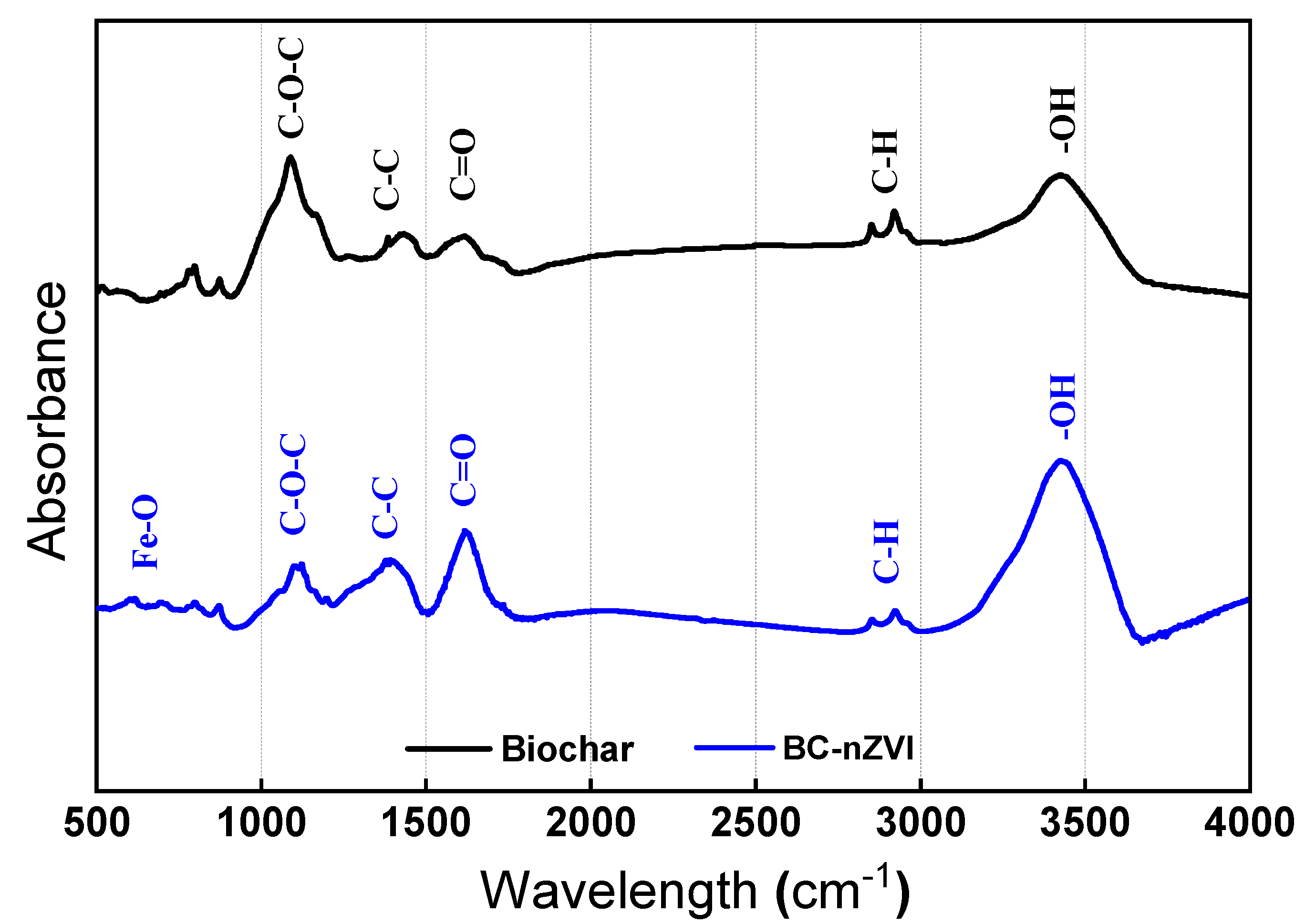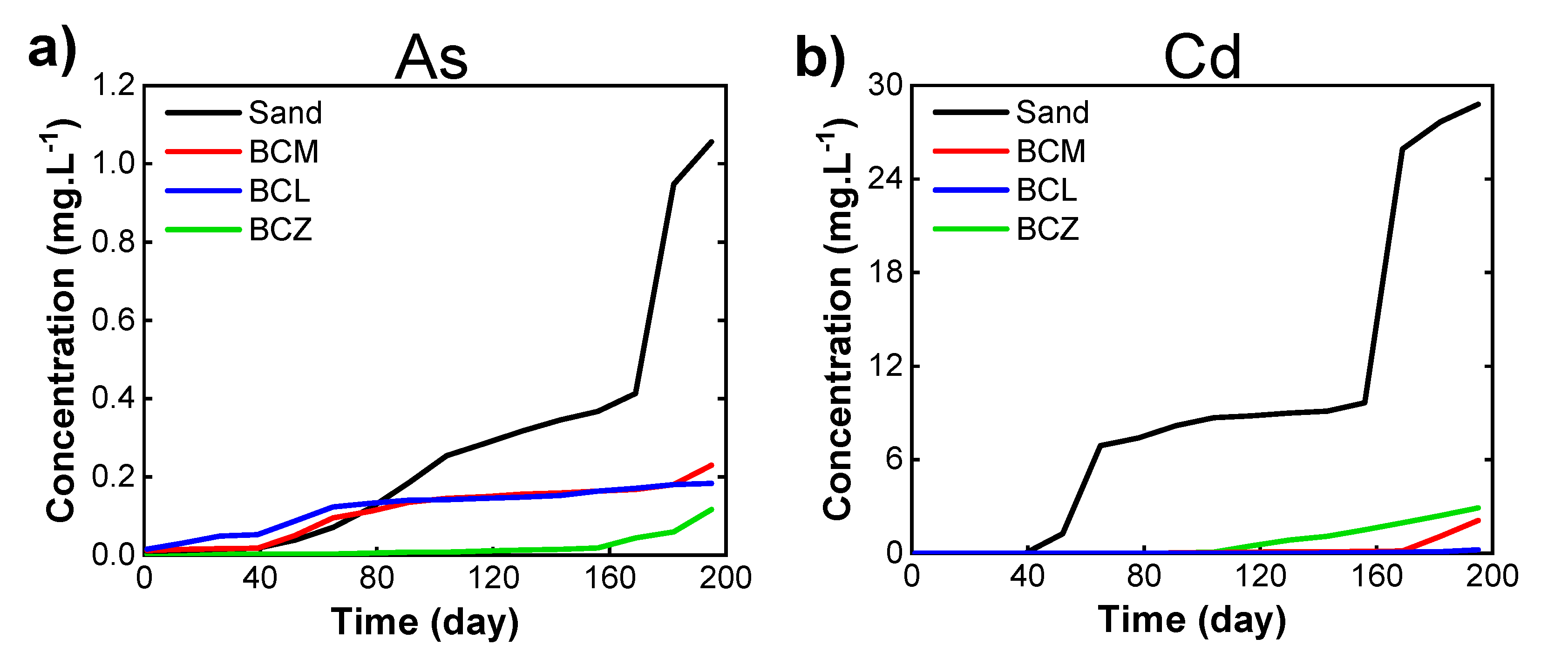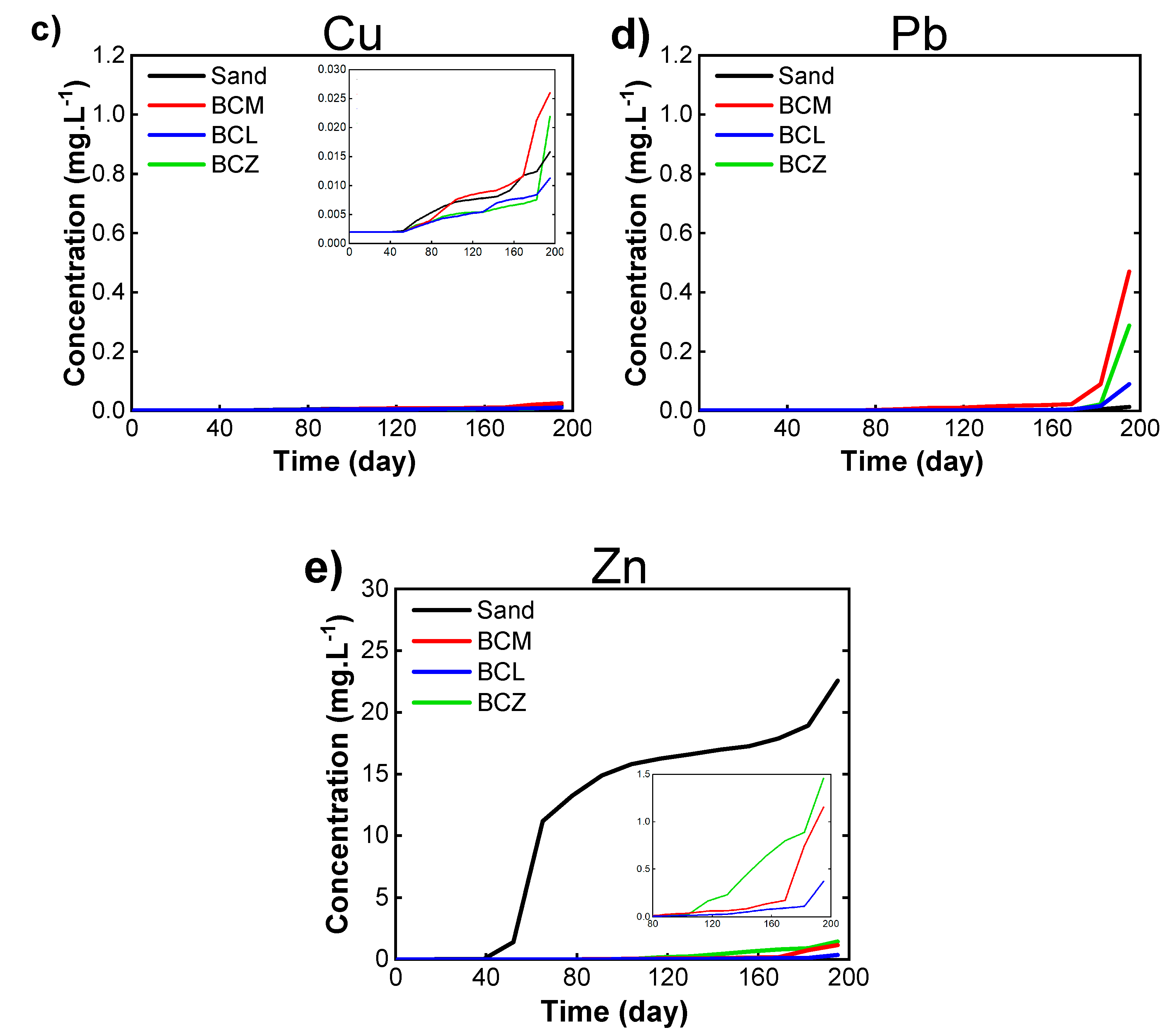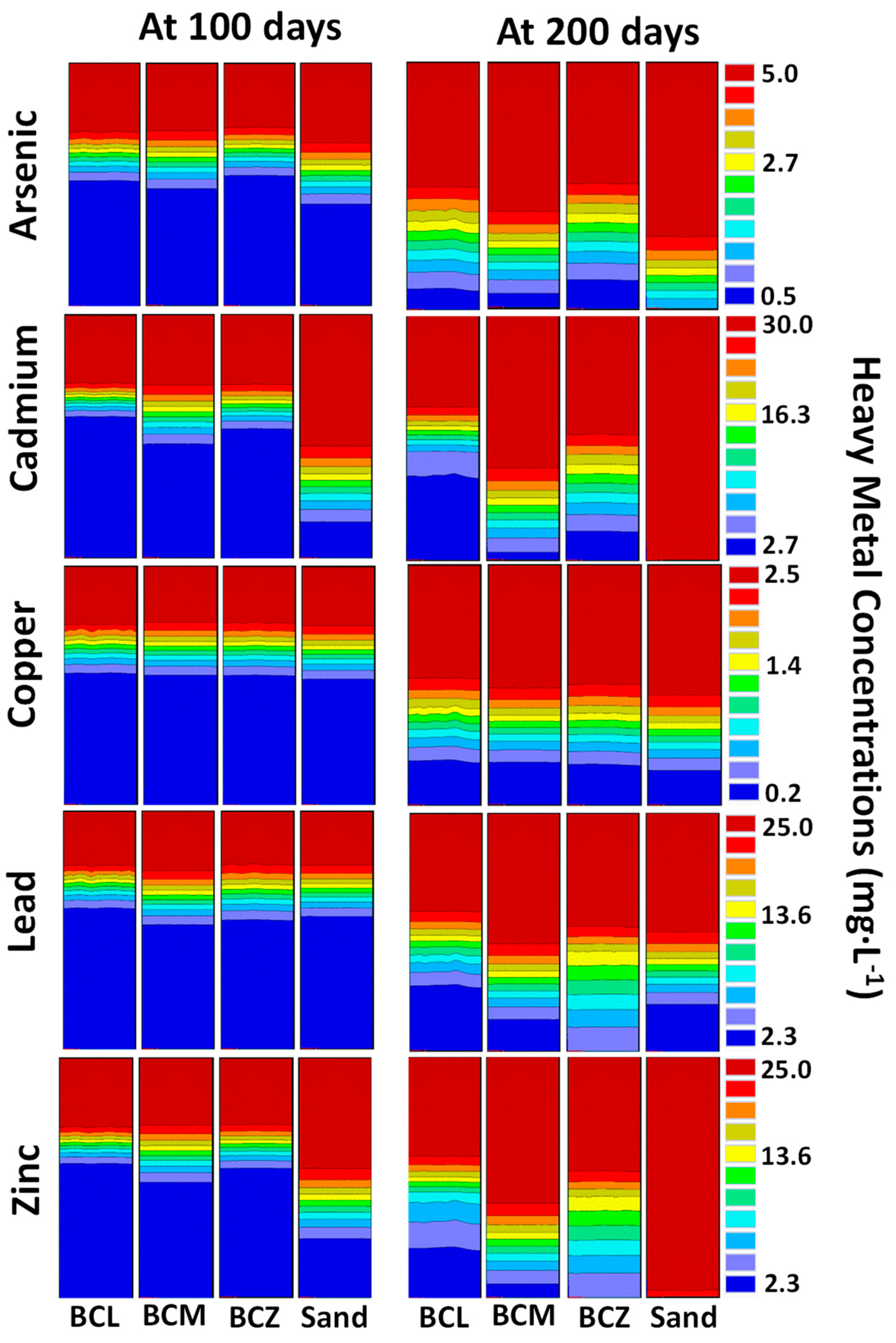Application of Biochar in Stormwater Treatment: Experimental and Modeling Investigation
Abstract
:1. Introduction
2. Materials and Methods
2.1. Experimental Investigation
2.1.1. Column Media and Reagents
2.1.2. Stormwater Solution
2.1.3. Column Setup
2.2. Media Characterization and Data Analysis
2.3. Modeling Investigation
2.3.1. Modeling of Hydraulic Parameters
2.3.2. Modeling of the Metal Transport
3. Results and Discussion
3.1. Media Characteristics
3.2. Media Metal and Metalloid Removal Performance Evaluations
3.2.1. Metal/Metalloid Concentration Changes over Time
3.2.2. Removal Efficiencies of Media
3.3. Model Investigations
3.3.1. Media Hydraulic Parameters
3.3.2. Metal/Metalloid Transport Model Outputs
4. Conclusions
Supplementary Materials
Author Contributions
Funding
Institutional Review Board Statement
Informed Consent Statement
Data Availability Statement
Acknowledgments
Conflicts of Interest
References
- Goonetilleke, A.; Thomas, E.; Ginn, S.; Gilbert, D. Understanding the role of land use in urban stormwater quality management. J. Environ. Manag. 2005, 74, 31–42. [Google Scholar] [CrossRef] [Green Version]
- Mohammed, A.S.; Kapri, A.; Goel, R. Heavy metal pollution: Source, impact, and remedies. In Biomanagement of Metal-Contaminated Soils; Springer: Dordrecht, The Netherlands, 2011; pp. 1–28. [Google Scholar]
- Mulligan, C.; Yong, R.; Gibbs, B. Remediation technologies for metal-contaminated soils and groundwater: An evaluation. Eng. Geol. 2001, 60, 193–207. [Google Scholar] [CrossRef]
- Su, C. A review on heavy metal contamination in the soil worldwide: Situation, impact and remediation techniques. Environ. Skept. Crit. 2014, 3, 24–38. [Google Scholar]
- Jang, A.; Seo, Y.; Bishop, P.L. The removal of heavy metals in urban runoff by sorption on mulch. Environ. Pollut. 2005, 133, 117–127. [Google Scholar] [CrossRef]
- Cárdenas, G.; Orlando, P.; Edelio, T. Synthesis and applications of chitosan mercaptanes as heavy metal retention agent. Int. J. Biol. Macromol. 2001, 28, 167–174. [Google Scholar] [CrossRef]
- Erdem, E.; Karapinar, N.; Donat, R. The removal of heavy metal cations by natural zeolites. J. Colloid Interface Sci. 2004, 280, 309–314. [Google Scholar] [CrossRef]
- Brown, P.; Jefcoat, I.A.; Parrish, D.; Gill, S.; Graham, E. Evaluation of the adsorptive capacity of peanut hull pellets for heavy metals in solution. Adv. Environ. Res. 2000, 4, 19–29. [Google Scholar] [CrossRef]
- Hasan, S.; Geza, M.; Vasquez, R.; Chilkoor, G.; Gadhamshetty, V. Enhanced heavy metal removal from synthetic stormwater using nanoscale zerovalent iron-modified biochar. Water Air Soil Pollut. 2020, 231, 1–15. [Google Scholar] [CrossRef]
- Reddy, K.R.; Xie, T.; Dastgheibi, S. Evaluation of Biochar as a potential filter media for the removal of mixed contaminants from urban storm water runoff. J. Environ. Eng. 2014, 140, 04014043. [Google Scholar] [CrossRef] [Green Version]
- Komkiene, J.; Baltrenaite, E. Biochar as adsorbent for removal of heavy metal ions [Cadmium (II), Copper (II), Lead (II), Zinc (II)] from aqueous phase. Int. J. Environ. Sci. Technol. 2016, 13, 471–482. [Google Scholar]
- Shojaeizadeh, A.; Geza, M.; McCray, J.; Hogue, T.S. Site-scale integrated decision support tool (i-DSTss) for stormwater management. Water 2019, 11, 2022. [Google Scholar] [CrossRef] [Green Version]
- Shojaeizadeh, A.; Geza, M.; Bell, C.; McCray, J.; Hogue, T. A site-scale tool for performance-based design of stormwater best management practices. Water 2021, 13, 844. [Google Scholar] [CrossRef]
- Li, H.; Davis, A.P. Water quality improvement through reductions of pollutant loads using bioretention. J. Environ. Eng. 2009, 135, 567–576. [Google Scholar] [CrossRef]
- Winston, R.J.; Dorsey, J.D.; Hunt, W.F. Quantifying volume reduction and peak flow mitigation for three bioretention cells in clay soils in Northeast Ohio. Sci. Total Environ. 2016, 553, 83–95. [Google Scholar] [CrossRef]
- Chapman, C.; Horner, R.R. Performance assessment of a street-drainage bioretention system. Water Environ. Res. 2010, 82, 109–119. [Google Scholar] [CrossRef]
- Kobya, M.; Demirbas, E.; Senturk, E.; Ince, M. Adsorption of heavy metal ions from aqueous solutions by activated carbon prepared from apricot stone. Bioresour. Technol. 2005, 96, 1518–1521. [Google Scholar] [CrossRef]
- Kabir, T.; Hasan, M.S.; Das, P. Applicability of activated carbon filtration in surface water treatment. Asian J. Innov. Res. Sci. Eng. Technol. 2016, 1, 1–6. [Google Scholar]
- Akhil, D.; Lakshmi, D.; Kartik, A.; Vo, D.-V.N.; Arun, J.; Gopinath, K.P. Production, characterization, activation and environmental applications of engineered biochar: A review. Environ. Chem. Lett. 2021, 1–37. [Google Scholar] [CrossRef]
- Ashoori, N.; Teixido, M.; Spahr, S.; LeFevre, G.H.; Sedlak, D.L.; Luthy, R.G. Evaluation of pilot-scale biochar-amended woodchip bioreactors to remove nitrate, metals, and trace organic contaminants from urban stormwater runoff. Water Res. 2019, 154, 1–11. [Google Scholar] [CrossRef]
- Mohanty, S.K.; Valenca, R.; Berger, A.W.; Yu, I.K.; Xiong, X.; Saunders, T.M.; Tsang, D.C. Plenty of room for carbon on the ground: Potential applications of biochar for stormwater treatment. Sci. Total Environ. 2018, 625, 1644–1658. [Google Scholar] [CrossRef]
- Ulrich, B.A.; Im, E.A.; Werner, D.; Higgins, C.P. Biochar and activated carbon for enhanced trace organic contaminant retention in stormwater infiltration systems. Environ. Sci. Technol. 2015, 49, 6222–6230. [Google Scholar] [CrossRef]
- Lehmann, J.; Joseph, S. (Eds.) Biochar for Environmental Management: Science, Technology and Implementation; Routledge: London, UK, 2015. [Google Scholar]
- Woolf, D.; Amonette, J.E.; Street-Perrott, F.A.; Lehmann, J.; Joseph, S.G. Sustainable biochar to mitigate global climate change. Nat. Commun. 2010, 1, 56. [Google Scholar] [CrossRef] [Green Version]
- Ahmad, M.; Rajapaksha, A.U.; Lim, J.E.; Zhang, M.; Bolan, N.; Mohan, D.; Vithanage, M.; Lee, S.S.; Ok, Y.S. Biochar as a sorbent for contaminant management in soil and water: A review. Chemosphere 2014, 99, 19–33. [Google Scholar]
- Liang, B.; Lehmann, J.; Solomon, D.; Kinyangi, J.; Grossman, J.; O’Neill, B.; Skjemstad, J.O.; Thies, J.; Luizão, F.J.; Petersen, J.; et al. Black carbon increases cation exchange capacity in soils. Soil Sci. Soc. Am. J. 2006, 70, 1719–1730. [Google Scholar] [CrossRef] [Green Version]
- Nzediegwu, C.; Arshad, M.; Ulah, A.; Naeth, M.A.; Chang, S.X. Fuel, thermal and surface properties of microwave-pyrolyzed biochars depend on feedstock type and pyrolysis temperature. Bioresour. Technol. 2021, 320, 124282. [Google Scholar] [CrossRef]
- Li, H.; Dong, X.; da Silva, E.B.; de Oliveira, L.M.; Chen, Y.; Ma, L.Q. Mechanisms of metal sorption by biochars: Biochar characteristics and modifications. Chemosphere 2017, 178, 466–478. [Google Scholar] [CrossRef]
- Zhang, W.-X. Nanoscale iron particles for environmental remediation: An overview. J. Nanopart. Res. 2003, 5, 323–332. [Google Scholar] [CrossRef]
- Coston, J.A.; Fuller, C.C.; Davis, J.A. Pb2+ and Zn2+ adsorption by a natural aluminum- and iron-bearing surface coating on an aquifer sand. Geochim. Cosmochim. Acta 1995, 59, 3535–3547. [Google Scholar] [CrossRef]
- Agrawal, A.; Sahu, K. Kinetic and isotherm studies of cadmium adsorption on manganese nodule residue. J. Hazard. Mater. 2006, 137, 915–924. [Google Scholar] [CrossRef]
- Hasan, S.; Geza, M.; Petersen, J.B.; Gadhamshetty, V. Graphene oxide transport and retention in biochar media. Chemosphere 2021, 264, 128397. [Google Scholar] [CrossRef]
- Shu, H.-Y.; Chang, M.-C.; Chen, C.-C.; Chen, P.-E. Using resin supported nano zero-valent iron particles for decoloration of Acid Blue 113 azo dye solution. J. Hazard. Mater. 2010, 184, 499–505. [Google Scholar] [CrossRef]
- Zhou, Y.; Gao, B.; Zimmerman, A.R.; Chen, H.; Zhang, M.; Cao, X. Biochar-supported zerovalent iron for removal of various contaminants from aqueous solutions. Bioresour. Technol. 2014, 152, 538–542. [Google Scholar] [CrossRef]
- Tian, J.; Jin, J.; Chiu, P.C.; Cha, D.K.; Guo, M.; Imhoff, P.T. A pilot-scale, bi-layer bioretention system with biochar and zero-valent iron for enhanced nitrate removal from stormwater. Water Res. 2019, 148, 378–387. [Google Scholar] [CrossRef]
- Lau, A.Y.; Tsang, D.C.; Graham, N.J.; Ok, Y.S.; Yang, X.; Li, X.-D. Surface-modified biochar in a bioretention system for Escherichia coli removal from stormwater. Chemosphere 2017, 169, 89–98. [Google Scholar] [CrossRef]
- Amen, R.; Bashir, H.; Bibi, I.; Shaheen, S.M.; Niazi, N.K.; Shahid, M.; Hussain, M.M.; Antoniadis, V.; Shakoor, M.B.; Al-Solaimani, S.G.; et al. A critical review on arsenic removal from water using biochar-based sorbents: The significance of modification and redox reactions. Chem. Eng. J. 2020, 396, 125195. [Google Scholar] [CrossRef]
- Reddy, K.R.; Dastgheibi, S.; Cameselle, C. Mixed versus layered multi-media filter for simultaneous removal of nutrients and heavy metals from urban stormwater runoff. Environ. Sci. Pollut. Res. 2021, 28, 7574–7585. [Google Scholar] [CrossRef]
- Yan, J.; Han, L.; Gao, W.; Xue, S.; Chen, M. Biochar supported nanoscale zerovalent iron composite used as persulfate activator for removing trichloroethylene. Bioresour. Technol. 2015, 175, 269–274. [Google Scholar] [CrossRef]
- Grebel, J.E.; Mohanty, S.K.; Torkelson, A.A.; Boehm, A.B.; Higgins, C.P.; Maxwell, R.M.; Nelson, K.L.; Sedlak, D.L. Engineered infiltration systems for urban stormwater reclamation. Environ. Eng. Sci. 2013, 30, 437–454. [Google Scholar] [CrossRef]
- Grebel, J.E.; Charbonnet, J.A.; Sedlak, D.L. Oxidation of organic contaminants by manganese oxide geomedia for passive urban stormwater treatment systems. Water Res. 2016, 88, 481–491. [Google Scholar] [CrossRef]
- Liu, Q.; Wu, L.; Gorring, M.; Deng, Y. Aluminum-impregnated biochar for adsorption of arsenic (V) in urban stormwater runoff. J. Environ. Eng. 2019, 145, 04019008. [Google Scholar] [CrossRef]
- Li, H.; Liu, Y.; Chen, Y.; Wang, S.; Wang, M.; Xie, T.; Wang, G. Biochar amendment immobilizes lead in rice paddy soils and reduces its phytoavailability. Sci. Rep. 2016, 6, 31616. [Google Scholar] [CrossRef]
- Jain, M.S.; Jambhulkar, R.; Kalamdhad, A.S. Biochar amendment for batch composting of nitrogen rich organic waste: Effect on degradation kinetics, composting physics and nutritional properties. Bioresour. Technol. 2018, 253, 204–213. [Google Scholar] [CrossRef]
- Šimůnek, J.; van Genuchten, M.; Sejna, M. HYDRUS Technical Manual: The HYDRUS Software Package for Simulating the Two-and Three Dimensional Movement of Water, Heat and Multiple Solutes in Variably-Saturated Porous Media; Technical Manual Version 2; PC-Progress: Prague, Czech Republic, 2012. [Google Scholar]
- Mualem, Y. A new model for predicting the hydraulic conductivity of unsaturated porous media. Water Resour. Res. 1976, 12, 513–522. [Google Scholar] [CrossRef] [Green Version]
- Van Genuchten, M.T. A closed-form equation for predicting the hydraulic conductivity of unsaturated soils. Soil Sci. Soc. Am. J. 1980, 44, 892–898. [Google Scholar] [CrossRef] [Green Version]
- Lara, N.; Figueroa, L.; Carvajal, F.; Zapata, Y.; Urbina, C.; Escobar, H. Quantitative differentiation between soil organic carbon and biochar carbon in Aridisol. Int. J. Agric. Nat. Resour. 2013, 40, 387–395. [Google Scholar]
- Ahangaran, F.; Hassanzadeh, A.; Nouri, S. Surface modification of Fe3O4@SiO2 microsphere by silane coupling agent. Int. Nano Lett. 2013, 3, 23. [Google Scholar] [CrossRef]
- Niazi, N.K.; Bibi, I.; Shahid, M.; Ok, Y.S.; Burton, E.D.; Wang, H.; Shaheen, S.M.; Rinklebe, J.; Lüttge, A. Arsenic removal by perilla leaf biochar in aqueous solutions and groundwater: An integrated spectroscopic and microscopic examination. Environ. Pollut. 2018, 232, 31–41. [Google Scholar] [CrossRef]
- Liu, X.; Gao, M.; Qiu, W.; Khan, Z.H.; Liu, N.; Lin, L.; Song, Z. Fe-Mn-Ce oxide-modified biochar composites as efficient adsorbents for removing As(III) from water: Adsorption performance and mechanisms. Environ. Sci. Pollut. Res. 2019, 26, 17373–17382. [Google Scholar] [CrossRef]
- Han, Z.; Sani, B.; Mrozik, W.; Obst, M.; Beckingham, B.; Karapanagioti, H.K.; Werner, D. Magnetite impregnation effects on the sorbent properties of activated carbons and biochars. Water Res. 2015, 70, 394–403. [Google Scholar] [CrossRef] [Green Version]
- Zhu, S.; Ho, S.-H.; Huang, X.; Wang, D.; Yang, F.; Wang, L.; Wang, C.; Cao, X.; Ma, F. Magnetic nanoscale zerovalent iron assisted biochar: Interfacial chemical behaviors and heavy metals remediation performance. ACS Sustain. Chem. Eng. 2017, 5, 9673–9682. [Google Scholar] [CrossRef]
- Harvey, O.R.; Herbert, B.E.; Rhue, R.D.; Kuo, L.-J. Metal interactions at the biochar-water interface: Energetics and structure-sorption relationships elucidated by flow adsorption microcalorimetry. Environ. Sci. Technol. 2011, 45, 5550–5556. [Google Scholar] [CrossRef]
- Stenstrom, M.K.; Kayhanian, M. First Flush Phenomenon Characterization; California Department of Transportation Division of Environmental Analysis: Sacramento, CA, USA, 2005. [Google Scholar]
- Geza, M.; Deb, S.K.; Leinauer, B.; Stanek, S.; Sevostianova, E.; Serena, M. Modeling NO3-N leaching during establishment of turfgrasses irrigated with tailored reclaimed water. Vadose Zone J. 2021, e20112. [Google Scholar] [CrossRef]
- Geza, M.; Lowe, K.S.; Huntzinger, D.N.; McCray, J.E. New conceptual model for soil treatment units: Formation of multiple hydraulic zones during unsaturated wastewater infiltration. J. Environ. Qual. 2013, 42, 1196–1204. [Google Scholar] [CrossRef]








| Constituents | Concentration [22,40,41] | |
|---|---|---|
| (mM) | (mg·L−1) | |
| Ca2+ | 0.750 | 30.10 |
| Mg2+ | 0.075 | 1.80 |
| Na+ | 1.750 | 40.30 |
| NH4+ | 0.072 | 1.30 |
| SO42− | 0.330 | 31.70 |
| HCO3− | 1.000 | 61.00 |
| Cl− | 1.700 | 60.30 |
| NO3− | 0.072 | 4.50 |
| H2PO4− | 0.016 | 1.60 |
| Metal/Metalloid Ion | Average Range in Actual Stormwater (mg·L−1) [10,42] | Concentration (mg·L−1) in This Study | Source Chemical |
|---|---|---|---|
| As3+ | 0.00005–2.00 | 5 | NaAsO2 |
| Cd2+ | 0.00005–13.73 | 30 | CdCl2 |
| Cu2+ | 0.00006–1.41 | 2.5 | CuSO4 |
| Pb2+ | 0.00057–26.00 | 25 | Pb (NO3)2 |
| Zn2+ | 0.0007–22.00 | 25 | ZnSO4 |
| Column | Media | |||||
|---|---|---|---|---|---|---|
| Sand | Only sand | 0.002 | 0.478 | 0.08 | 4.4433 | 711.169 |
| BCM | Biochar and sand mixture | 0.136 | 0.484 | 0.024 | 1.788 | 31.243 |
| BCL | Sand | 0.035 | 0.365 | 0.141 | 1.719 | 711.409 |
| Biochar | 0.3 | 0.626 | 0.001 | 2.56 | 16.532 | |
| BCZ | Sand | 0.035 | 0.365 | 0.069 | 2.226 | 710.76 |
| BC-nZVI | 0.3 | 0.439 | 0.093 | 1.168 | 30.413 |
| Column | |||||
|---|---|---|---|---|---|
| As | Cd | Cu | Pb | Zn | |
| Sand | 14.6 | 9.5 | 18.5 | 19.9 | 10.9 |
| BCM | 16.6 | 16.1 | 19.3 | 18.2 | 16.6 |
| BCL | 22.5 | 44.9 | 21.5 | 25.9 | 36.7 |
| BCZ | 22.6 | 26.5 | 20 | 18.8 | 26 |
Publisher’s Note: MDPI stays neutral with regard to jurisdictional claims in published maps and institutional affiliations. |
© 2021 by the authors. Licensee MDPI, Basel, Switzerland. This article is an open access article distributed under the terms and conditions of the Creative Commons Attribution (CC BY) license (https://creativecommons.org/licenses/by/4.0/).
Share and Cite
Hasan, M.S.; Vasquez, R.; Geza, M. Application of Biochar in Stormwater Treatment: Experimental and Modeling Investigation. Processes 2021, 9, 860. https://doi.org/10.3390/pr9050860
Hasan MS, Vasquez R, Geza M. Application of Biochar in Stormwater Treatment: Experimental and Modeling Investigation. Processes. 2021; 9(5):860. https://doi.org/10.3390/pr9050860
Chicago/Turabian StyleHasan, Md Sazadul, Raul Vasquez, and Mengistu Geza. 2021. "Application of Biochar in Stormwater Treatment: Experimental and Modeling Investigation" Processes 9, no. 5: 860. https://doi.org/10.3390/pr9050860






